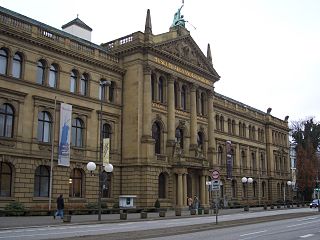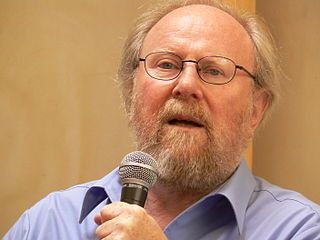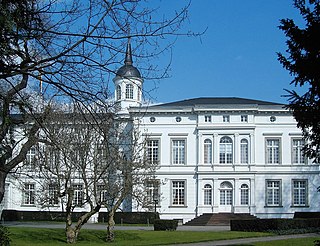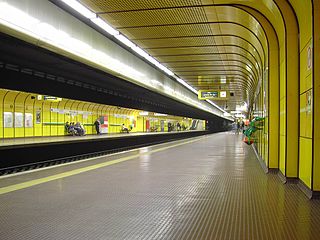
Bonn is a federal city in the German state of North Rhine-Westphalia, located on the banks of the Rhine. It has a population of over 300,000. About 24 km (15 mi) south-southeast of Cologne, Bonn is in the southernmost part of the Rhine-Ruhr region, Germany's largest metropolitan area, with over 11 million inhabitants. It is a university city, was the birthplace of Ludwig van Beethoven and was the capital of West Germany from 1949 to 1990. Bonn was the seat of government of reunited Germany from 1990 to 1999.

The Parlamentarischer Rat was the West German constituent assembly in Bonn that drafted and adopted the constitution of West Germany, the Basic Law for the Federal Republic of Germany, promulgated on 23 May 1949.

Wolfgang Thierse is a German politician of the Social Democratic Party (SPD). He served as the 11th president of the Bundestag from 1998 to 2005.

Alexander Sebastian Léonce Freiherr von der Wenge Graf Lambsdorff, commonly known as Alexander Graf Lambsdorff is a German politician of the Free Democratic Party of Germany (FDP), part of the Alliance of Liberals and Democrats for Europe, who has been serving as the German ambassador to Russia since 2023.

The German Historical Museum, known by the acronym DHM, is a museum in Berlin, Germany devoted to German history. It describes itself as a place of "enlightenment and understanding of the shared history of Germans and Europeans". It is often viewed as one of the most important museums in Berlin and is one of the most frequented. The museum is located in the 17th century Zeughaus (armory) on the Unter den Linden, just across the Spree from Museum Island. The museum's attached Exhibition Hall was designed by I. M. Pei in the late 20th Century.

Palais Schaumburg is a neoclassical-style building in Bonn, Germany, which served as the primary official seat of the German Federal Chancellery and the primary official residence of the Chancellor of the Federal Republic of Germany from 1949 until 1976. As the headquarters of the Federal Chancellery, it was simply known as the House of the Federal Chancellor. Since 2001, Palais Schaumburg has served as the secondary official seat of the German Federal Chancellery and the secondary official residence of the Chancellor of the Federal Republic of Germany.
The Institute of Contemporary History in Munich was conceived in 1947 under the name Deutsches Institut für Geschichte der nationalsozialistischen Zeit. Founded by the German government and the State of Bavaria at the suggestion of the Allied Forces, it was established in 1949 and renamed in 1952. Its purpose is the analysis of contemporary German history.

Markus Meckel is a German theologian and politician. He was the penultimate foreign minister of the GDR and a member of the German Bundestag.

The Tränenpalast is a former border crossing point between East and West Berlin, at Berlin Friedrichstraße station, which was in operation between 1962 and 1989. It is now a museum with exhibitions about Berlin during the Cold War period and about the process of German reunification. It was the border crossing for travellers on the S-bahn, U-bahn and trains going between East and West Germany. It was used only for westbound border crossings. It had separate checkpoints for West Berliners, West Germans, foreigners, diplomats, transit travellers and East Germans.

Aydan Özoğuz is a German politician of the Social Democratic Party (SPD), who has been serving as a Vice-president of the German Bundestag since October 2021. She has been a member of the Bundestag since 2009 and served as deputy chairperson of the party from 2011 until 2017.

Heussallee/Museumsmeile is a station on the Bonn Stadtbahn served by SWB lines 63, 66, 67 and 68 and KVB's line 16.

Stephan Ernst Johann Mayer is a German lawyer and politician of the Christian Social Union (CSU) who has been a member of the German Bundestag since 2002. In 2022, he briefly served as the Secretary General of the CSU, under the leadership of the party's chairman Markus Söder.

Permanent Missions of Federal Republic of Germany (FRG) and the German Democratic Republic (GDR) were permanent representative missions established in a 1972 treaty and effective from 1973 to 1989 "in the seats of their respective governments" according to Article 8 of the Basic Treaty. They served as de facto embassies for each other.
The Museum in the Kulturbrauerei is a museum of contemporary German history. The permanent exhibition focuses on everyday life in the German Democratic Republic. It is located in the Kulturbrauerei building complex in Prenzlauer Berg district in Berlin, Germany.

The Zeitgeschichtliches Forum Leipzig is a museum of contemporary German history. The museum was opened in 1999 and focuses on the history of the German division, everyday life in the communist dictatorship of the GDR, and the reunification process. It is located in the Grimmaische Strasse in the city center of Leipzig, Germany. A landmark of the museum is the sculpture The Step of the Century by Wolfgang Mattheuer in front of it.

Monika Grütters is a German politician of the Christian Democratic Union (CDU) who served as Federal Government Commissioner for Culture and the Media in the government of Chancellor Angela Merkel from 2013-2021. She has been a member of the German Bundestag since 2005 and was chairwoman of the Committee on Culture and Media Affairs from 2009 to 2013. Since December 2016, Grütters has also been the chairwoman of the CDU Berlin and an elected member of the CDU Federal Executive Board.

The visit of Erich Honecker to West Germany took place between 7–11 September 1987 in his official capacity as General Secretary of the Socialist Unity Party of Germany (SED) and Chairman of the State Council of the German Democratic Republic. It was the first and only visit of this kind undertaken during the partition of Germany. The five-day event was rated as an important step in the development of cross-German relations as well as Ostpolitik, which was implemented beginning with Willy Brandt, Chancellor of West Germany from 1969 to 1974.

Helge Frederik Lindh is a German politician of the Social Democratic Party (SPD) who has been serving as a member of the Bundestag since 2017, representing the Wuppertal I district.
Katrin Uhlig is a German politician of the Alliance 90/The Greens who has been serving as a member of the Bundestag after the 2021 German federal election, representing the electoral constituency of Bonn.

Inner German relations, also known as the FRG-GDR relations, East Germany-West Germanyrelations or German-German relations, were the political, diplomatic, economic, cultural and personal contacts between the Federal Republic of Germany and the German Democratic Republic, at the period of the West-East division in German history from the founding of East Germany on 7 October 1949 to Germany's reunification on 3 October 1990.



















